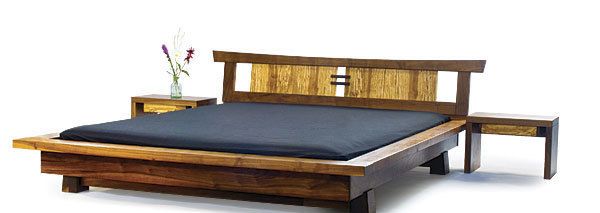6 Ways to Build a Bed
Six smart approaches cover almost any bed you can dream up
Synopsis: Often the most important pieces of furniture in the house, beds can be a challenge to build. They are large and bulky, and the joints connecting their headboards and footboards must be bombproof, but also knockdown to allow the bed to be moved. There are many ways to address those construction challenges, though, and many approaches to bed design. We scoured the woodworking world to find six of the best: traditional pencil-post, contemporary pencil-post, frame-and-slats, platform, frame-and-panel, and solid slab construction. No matter what style of bed you are making, you’ll find a technique here that can get the job done.
From Fine Woodworking #220
Beds may be the most important pieces of furniture in the house. Not only do you spend a third of your life in them, but their sheer size makes them the focal point of whatever room they inhabit, and a grand canvas for fine wood and craftsmanship.
Beds also pose unique challenges to the woodworker. Headboards (and footboards) are usually held upright by only two joints, which must also knock down to allow the bed to be moved. Beds are also large and bulky, requiring creative methods to deal with the big workpieces. Furniture makers past and present have addressed these challenges in a wide variety of ways; in fact, supporting a mattress may be the only thing beds have in common. For this article, I scoured the woodworking world to find six of the best approaches to bed design, taking a close look at how their makers managed the dance between looks and construction.
All of these skilled pros started with the same realities: mattress size and the desired mattress height. Then they confronted the knock-down joinery, making the side rails removable. While there are numerous ways to support a mattress, most custom makers go with some version of ledger strips and simple wood slats. Mattress manufacturers make a lot of money selling box springs, but slats achieve the same end while saving you hundreds of dollars. Either way, the choice affects mattress height.
After you deal with the inescapable realities, though, a bed leaves you plenty of room to express yourself. Some makers rely on tradition for design and construction, while others make their own rules. Whether your tastes lean toward the 18th century or the 21st, the six construction methods shown here should cover almost any bed you can imagine.
Traditional pencil-post “This pattern was probably taken from an 18th-century bed that came into the shop for my father to repair,” says Lou Irion, former owner of Irion Company Furniture Makers in Christiana, Pa. Jonathan Sanbuichi, who now runs the company, builds this bed the same way it was done for generations.
When assembled, the headboard and footboard on this bed are too tall to fit through standard doorways, so tall-post designs are engineered to break down completely. To this end, posts attach to the headboard, footboard, and side rails using shallow tenons and traditional bed bolts hidden by bolt covers of varying designs.
The upper portions of the posts are tapered and hexagonal at the top, with hand-carved lamb’s tongues where the taper begins. The upward sweep of the posts draws the eyes upward toward the tester, or canopy. Joining the tester to the posts is straight forward: The maker drives nails into the tops of the posts, removes their heads, and the four corners of the tester are then drilled so that they simply slide in place over the headless nails.
For the full article, download the PDF below:
Fine Woodworking Recommended Products

Bessey K-Body Parallel-Jaw Clamp

Dubuque Clamp Works Bar Clamps - 4 pack

Bessey EKH Trigger Clamps























Log in or create an account to post a comment.
Sign up Log in